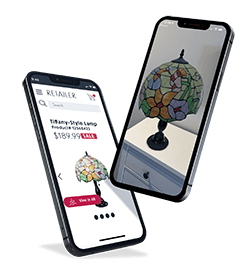Augmented Reality (AR)
Augmented Reality is a technology that superimposes a computer-generated image, video, or 3D model on a user’s view of the real world. Augmented Reality employs device cameras or sensors to map and identify the external environment.
AR Overlay
An image or graphic superimposed over an Image Target (see “Image Target”).
AR Video Playback
A video anchored in 3D space (typically superimposed on an Image Target) while maintaining the view of the physical environment as opposed to full screen playback.
Chroma Key Video
Popular for AR experiences, Chroma Key Video allows for the projection of video content into live environments. It is defined as video shot on a unique, brightly colored background (often called a “green screen”). Best practices in video production recommend using green or blue colored backgrounds for the best results. This technique allows the video editor to remove the brightly colored areas in the footage and replace those regions with transparent pixels. This technique is often used in weather broadcasts on local television news.
Extended Tracking
Allows you to launch the AR experience with an Image Target in the camera’s view, where the image experience persists even when you’re not tracking the image. This is particularly useful for visualizing large or complex objects that may be larger than the Image Target.
Hotspots
Tappable spots within the AR experience that reveal more content or options. Hotspots can be animated and are often shown as a glowing orb.
Image Target (also: trackable, trigger, marker, AR target)
The image recognized by the App, which launches the AR experience. Images with high contrast and unique features with sharp edges are key pillars in supporting image recognition.
Interactive Video
A video with features, such as hotspots, that call for the user to interact with the video.
Markerless AR (also: dead reckoning)
Augmented Reality that maps the physical environment in real-time. Often uses a smartphone camera and sensors to position a virtual object in a room without the need for Image Targets.
Virtual Reality
The computer-generated simulation of a three-dimensional image or environment that can be interacted with in a seemingly real or physical way by a person using special electronic equipment, such as the Oculus Rift.
Types of Augmented Reality Apps
Augmented Reality viewer App
An AR app, such as Layar or Aurasma, that is designed to provide Augmented Reality viewing experiences across multiple brands and content types.
Custom Campaign App
An AR app with 1 to 5 experiences that is published and available through the Apple App Store and/or Google Play.
Custom Event App
An AR app with 1 to 5 experiences used for a trade show or live event that is distributed to dedicated event iPads. Event apps are not available on the Apple App Store or Google Play. Event apps typically have a life span of 3 to 6 months.
Custom App vs. Universal App
A custom app is client-branded, developed, and licensed for use by one client. A universal app is a vendor-branded app (i.e. Aurasma or Layar) that uses a single universal app to view all clients’ AR experiences. Marxent is a custom app Augmented Reality vendor.
Augmented Reality Platforms & Technologies
Qualcomm® Vuforia™
Vuforia is a software platform that uses top-notch, consistent, and technically resourceful computer vision-based image recognition and offers a wide set of features and capabilities. Marxent is a Qualcomm Vuforia preferred vendor.
Unity 3D
Unity 3D is a cross-platform game engine developed by Unity Technologies. It is used to develop video games for web plugins, desktop platforms, consoles, and mobile devices. Marxent uses Unity 3D to implement 3D models within Augmented Reality apps.
VisualCommerce® (V-Commerce)
The ‘unlimited AR’ platform for hosted, downloadable content. Visual Commerce apps are typically developed as a sales support tool, like a virtual product trial with the option to purchase. The V-Commerce™ platform is intended for AR apps that will be expanded on over time, adding new content or experiences.
AR App Development & Publishing
Android
An open-source operating system for mobile devices created by Google.
App Publishing
Publishing an app allows users to download the app via the Apple App Store and/or Google Play.
Apple App Store
Apple’s app market for purchasing and downloading apps for use on Apple devices, such as the iPhone and iPad.
Google Play
Google’s online store for purchasing and downloading apps for use on Android-powered smartphones, tablets, Google TV and other similar devices.
iOS
An operating system used for mobile devices created by Apple.
Web Only AR
The ability to view 3D objects in the browser using a smart phone with a camera.
GLTF/GLB
The 3D File format used to launch web Augmented Reality experiences on Android phones.
USDZ
The 3D File format used to launch web Augmented Reality experiences on Apple phones.







